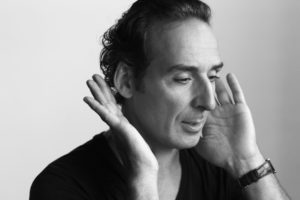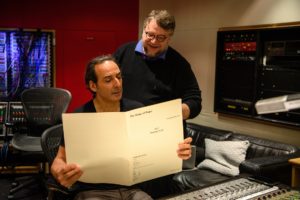
Composer Alexandre Desplat heard about the project three years ago and read the script for director Guillermo del Toro’s film, The Shape of Water before production began, but didn’t see the film until the cut was almost complete in January of 2017, and didn’t start composing until April of that year for recording in May.
Although he appreciates the idea of sharing in the production experience, he explained, “It’s when the movie has its final shape that I can really grasp its depth. Otherwise, when the movie is still being searched by the editor and director, sometimes it’s not right, so how can the music be right.” The opening underwater sequence was a major inspiration for Desplat, “If there was not this incredible overture underwater, how would I start? How would I be able to draw the attention and the emotions of the audience into the film? So I need the puzzle to be in place to be able to figure out how to swim through it.”
In his process of discovering the themes for a score, Desplat likes to follow the characters. He tries to capture who they are with the music. The beauty of the shots contribute to his inspiration, but the story lines and characters drive him forward. “What they say. What they do. How they are. How they react to each other. That’s where it comes from,” shared Desplat. “It’s always a combination of an intellectual journey and the visual beauty of the movie.”

The most important instrumentation choice for the score was the use of twelve flutes, many more than the three to five commonly used in an orchestra. A flutist himself, Desplat knew that twelve flutes playing a melody that is doubled by the piano and whistling would create the sensation of being underwater. “I always try to find what is the sound of the film,” stated Desplat. “In this film we start in water and we end in water. Water is the main asset. It’s love and water. How that sounds you have to figure out and imagine a combination of sounds that can make you feel you are underwater.”
The whistling of the melody line in the beginning sequence, gives the music a wistful sound and a very human touch. Desplat whistled the melody line to del Toro. The company hired a world-class whistler to lay down tracks, but although technically proficient, the performance lacked heart, so Desplat’s rendition was used. The composer chose whistling and piano over strings because he felt if strings played the theme in the opening, it would be “so schmaltzy, so over the top.” He wanted the feeling to be restrained and floating. He didn’t want the music to say too much. Strings work later in the film when the score needs to be much bigger. And a single violin is used in the end when the music comes back down to something simpler and very minimal.
The ability of musical composers, like Cole Porter, to take a play from one plateau to the next until the peak is reached, was a template for what Desplat intended to do with the score over the course of this story. “It started from almost nothing and goes bigger and bigger and bigger, and at the end, it goes back to small,” Desplat noted.
Other ideas were influential in the score. The creature comes from South America. Desplat did not want to use anything too obvious, like Brazilian bells or samba rhythm. He chose accordion because the director kept saying the film was his “French movie.”
The film is a love story, but it also has a suspense aspect with the dark edge of the cold war and evil sadistic experiments. The different tone of that part of the story presented a challenge for the composer. The long escape from the laboratory cue is the only moment when Desplat brings in the horns, the brass. “Through that, and all the way after that, there is no brass. It’s the same orchestra. I keep the same sound, but instead of playing the love theme, I play different themes with the same amount of musicians,” revealed Desplat. “We are bringing the same color. We have the twelve flutes. We have all these elements. Everyone is in a fish tank. The good guys and the bad guys are all in the same fish tank. It’s the same sound, just different melodies.”
Composing to Desplat is the same thing as orchestrating. He needs to hear every instrument and decides a melody line based on the nature of every instrument, whether a trumpet or a flute. Because of the set-up on his computer, Desplat is able to export a score exactly as he wants the music to be arranged for the orchestra. The process is extremely precise. Every single instrument is placed exactly as written. Desplat remarked, “It is a communication of what I feel when I watch the film.”





